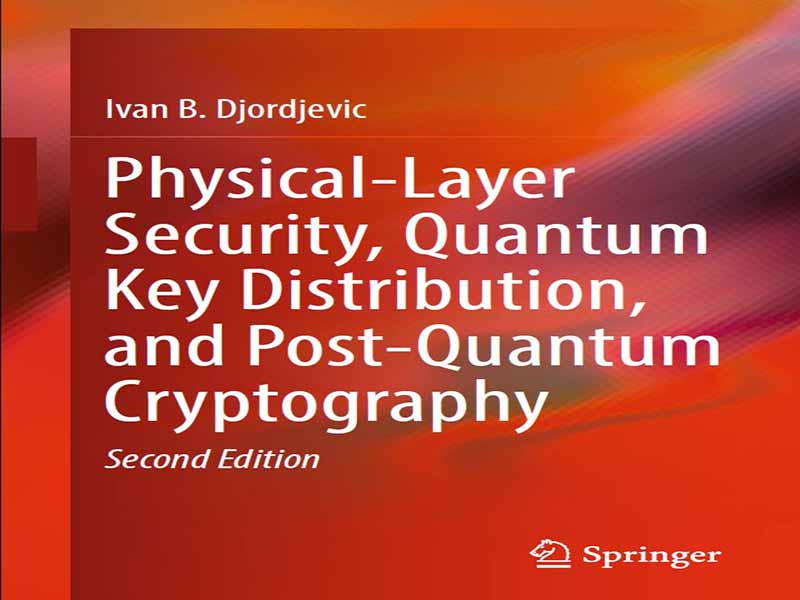- عنوان کتاب: Physical-Layer Security, Quantum Key Distribution, and Post-Quantum Cryptography, 2e
- نویسنده: Ivan B. Djordjevic
- حوزه: رمزنگاری
- سال انتشار: 2025
- تعداد صفحه: 607
- زبان اصلی: انگلیسی
- نوع فایل: pdf
- حجم فایل: 8.16 مگابایت
به نظر نمیرسد که رشد اینترنت و ترافیک دادهها به این زودیها متوقف شود و پیشبینی میشود که در سالهای آینده به صورت تصاعدی رشد کند. با این حال، لازم است که برای مقابله با کمبود پهنای باند ورودی، بهبود چشمگیری در نرخ انتقال سیگنال نوری ایجاد شود. اگرچه پیشنهادهای زیادی در مورد چگونگی بهبود کارایی طیفی وجود دارد، اما به نظر میرسد امنیت شبکههای نوری بسیار عقب مانده است. با اتصال به بخشی از سیگنال متراکم مالتیپلکسینگ تقسیم طول موج (DWDM)، میتوان حجم عظیمی از دادهها را به خطر انداخت. بنابراین، امنیت شبکههای نوری و شبکههای بیسیم به یکی از مسائل اصلی تبدیل میشود که باید زودتر از موعد به آن پرداخته شود. رمزنگاری کلید عمومی دارای چندین ایراد جدی است، پیادهسازی آن در دستگاههایی با حافظه کم و محدودیتهای پردازش کم دشوار است. فناوریهای اینترنت و بیسیم به طور فزایندهای در حال متحرک شدن هستند. طرحهای امنیتی مبتنی بر فرضیات اثبات نشدهای در مورد غیرقابل نفوذ بودن برخی توابع هستند، فرض محدود کردن منابع محاسباتی Eve اغلب نادرست است. به چند مورد اشاره میکنم. برای حل همزمان همه این مشکلات، باید مفاهیم امنیتی جدیدی مانند مواردی که در این کتاب شرح داده شده است، معرفی شوند. هدف این کتاب، آشنایی خواننده با پیشرفتهترین مباحث امنیت لایه فیزیکی (PLS)، رمزنگاری، ارتباطات پنهان/مخفی، توزیع کلید کوانتومی (QKD)، که با نام رمزنگاری کوانتومی نیز شناخته میشود، و رمزنگاری پساکوانتومی (PQC) است. تاکنون، این مباحث به عنوان رشتههای جداگانه در نظر گرفته شدهاند، اگرچه همان مشکلات امنیتی را که امروزه با آن مواجه هستیم، هدف قرار میدهند.
The growth of the Internet and data traffic does not appear to level off any time soon, and it is projected to continue to grow exponentially in years to come. It is, however, necessary to make a dramatic improvement in optical signal transmission rates to cope with the incoming bandwidth crunch. Although there are many proposals on how to improve spectral efficiency, the security of optical networks appears to lag far behind. By taping into the portion of dense wavelength-division multiplexing (DWDM) signal, a huge amount of data can be compromised. Therefore, the security of both optical networks and wireless networks is becoming one of the major issues to be addressed sooner rather than later. Public key cryptography has several serious drawbacks it is difficult to implement it in devices with low memory and low process constraints; Internet and wireless technologies are becoming increasingly mobile; security schemes are based on unproven assumptions of intractability of certain functions, the assumption of limiting computing resources of Eve is very often incorrect; to mention a few. To solve all these problems in a simultaneous manner, new security concepts must be introduced, such as those described in this book. The purpose of this book is to introduce the reader to the most advanced topics of physical-layer security (PLS), cryptography, covert/stealth communications, quantum key distribution (QKD), also known as quantum cryptography, and postquantum cryptography (PQC). So far, these topics have been considered as separate disciplines, even though they are targeting the same security problems we are facing today.
این کتاب را میتوانید از لینک زیر بصورت رایگان دانلود کنید:
Download: Physical-Layer Security, Quantum Key Distribution, and Post-Quantum Cryptography, 2e




































نظرات کاربران